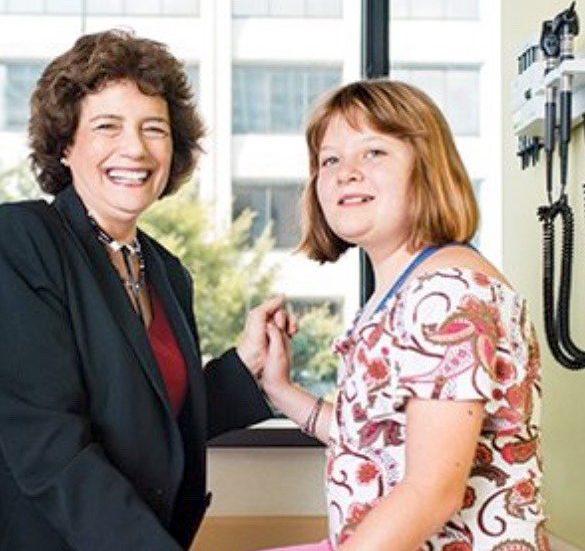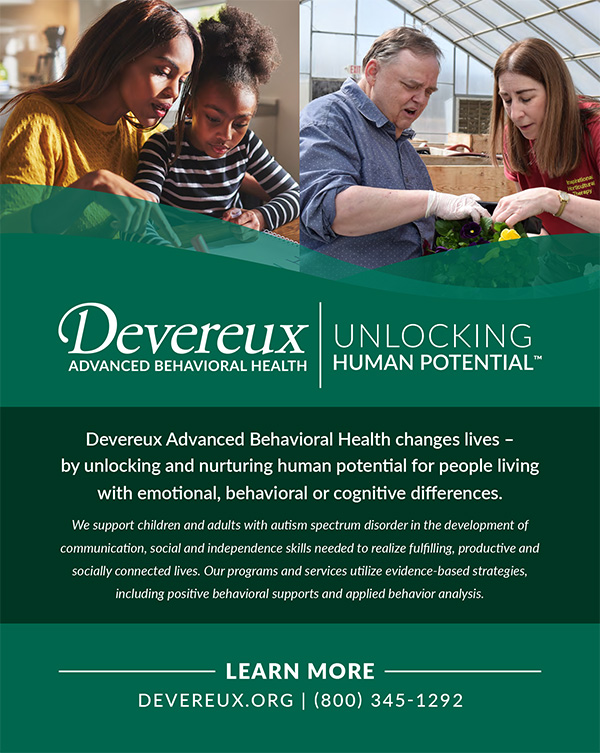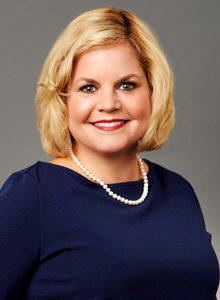I remember the day as if it was yesterday – Wednesday, Oct. 15, 2003. It was my birthday, and I had just met with my 21-month-old daughter’s pediatrician to discuss her “global developmental delays.” In the most caring way, he told us, “You will need to see a developmental-behavioral pediatrician. Unfortunately, it may take six to nine months, so I would call as soon as possible.” Adrenaline flowed through my veins as my fight-or-flight response kicked in. I asked my husband to take our daughter, Annie, to the car. I couldn’t wait to get home to make an appointment – I had to call right then and there.

Amy Kelly’s daughter, Annie, with retired Developmental Pediatrician, Dr. Susan Levy
It was 4:30 p.m., and I expected the office would be closed, and that I would need to leave a message. To my surprise, a man answered. I began to sob, apologizing as I told my story in between sniffles and gasps of air. I explained that I was six months pregnant with my third child, and that my daughter needed to be seen right away for unknown developmental and speech delays. The kind man on the other end of the phone said gently, “Well, we have a long waiting list, but I’m going to squeeze you in for an appointment in three weeks. My staff may not like that, but I’m the doctor,” he quipped.
Sure enough, it was the developmental-behavioral pediatrician himself answering the phone. That rarely occurs and I believe it happened for a reason. We began our series of appointments with him and, three months later, on the day before my sweet baby girl’s 2nd birthday, Annie was given the diagnosis of autism spectrum disorder.
Autism spectrum disorder (ASD) is a neurological and developmental disorder that affects how people interact with others, communicate, learn and behave. Although autism can be diagnosed at any age, it is described as a “developmental disorder” because symptoms generally appear in the first two years of life.1
The beginning of my family’s autism journey is not typical. Many families are in need of an autism expert, and they all can be difficult to access: developmental-behavioral pediatricians, child and adolescent psychiatrists, neurologists and psychologists.
Developmental-behavioral pediatricians (DBPs) are different from primary pediatricians who manage the standard, everyday care of children under age 21 and other specialists because they are trained specifically to care for children and adolescents with complex and severe developmental and behavioral disorders. Families who are trying to see a DBP wait an average of six months for an appointment – if they can even find one. According to the American Board of Pediatrics,2 there are fewer than 750 board certified DBPs available. Access to DBPs also varies across geographic location, with 29 states having fewer than one DBP per 100,000 children.3 Currently, more than 19 million children and adolescents across the U.S. under the age of 19 have a developmental disorder. This lack of specialists and access could have a significant impact on the future of children and families.
The Workforce Survey on Developmental-Behavioral Pediatrics revealed that more DBPs retire each year than new trainees and fellows enter the subspecialty. Over the next 10 years, one third of the existing DBPs are expected to retire,4 with fewer replacement DBPs in the pipeline. There is a real chance that the field of developmental-behavioral pediatrics could cease to exist if concerted efforts aren’t created to bring awareness and advocacy to this important specialty arena.
What Can I Do to Help?
If you are a family:
- Contact your local, state, and national policymakers and medical insurers to let them know your need of the developmental-behavioral pediatric specialty.
- Mention concerns to your primary pediatrician and ask them to broach the subject at their next local American Academy of Pediatrics (AAP) chapter meeting. Wide exposure to this encroaching crisis is essential to revitalizing the field.
If you are a professional in the field of developmental and behavioral disorders:
- Create interdisciplinary trainings with health care providers, psychologists, social workers, community health workers and family peer navigators to partner, share the vision, and advocate for the DBP workforce.
- If you work with developmental-behavioral pediatricians, bring them into the collaboration so they can talk firsthand about the shortages and how you can help.
If you are a healthcare collaborative or medical institution that trains medical professionals or provides care for those with developmental and behavioral disorders:
- Bring this to the attention of your leadership. Fundamental changes will be required, such as earlier training and awareness of the DBP field in medical school and residency, as well as improved debt forgiveness programs for medical school or higher reimbursement models for practices. This will be particularly important with the shift from volume-based to value-based payments, which could potentially support care coordination and other traditionally nonbillable services that are essential to the proper care of children with developmental and behavioral diagnoses.5
Children and adolescents with developmental and behavioral disorders will soon age into adulthood, which means they will need specialty care for their disorders in the adult-serving medical system. A recent study found that more than a third of doctors surveyed had little or no knowledge about their legal requirements and obligations under the Americans with Disabilities Act (ADA) for caring for people with disabilities.6
Let’s work together to ensure our children and adolescents with developmental and behavioral disorders get the right start to their medical care with an expert: a developmental-behavioral pediatrician.
Amy Kelly, MBA, MNM, is the mother to Danny, Annie and Ryan. Annie is diagnosed with moderate to severe autism, verbal apraxia, intellectual and developmental disabilities and general anxiety disorder. Amy is the National Director of Family Engagement for Devereux Advanced Behavioral Health, one of the nation’s oldest and largest nonprofit providers of behavioral healthcare, and serves as a family partner on several special needs boards including the American Academy of Pediatrics (AAP) Section on Developmental and Behavioral Pediatrics (SODBP) Executive Committee. In addition, she participates with other patients and families in efforts supported by the American Board of Pediatrics Foundation and the Autism Care Network to address children with special needs and the importance of quality family-centered care.
Footnotes
- https://www.nimh.nih.gov/health/topics/autism-spectrum-disorders-asd
- https://www.abp.org/content/data-and-workforce
- https://www.aap.org/en/advocacy/pediatric-subspecialty-shortages-fact-sheets/
- Leslie LK, Baum R, Turner A. Revisiting the Viability of the Developmental-Behavioral Health Care Workforce. Pediatrics. 2018; 141(3):e20174132
- Ibid.
- https://www.disabilityscoop.com/2022/01/11/doctors-know-little-about-their-obligations-to-people-with-disabilities-study-finds/29652/







you state that “Currently, more than 19 million children and adolescents across the U.S. under the age of 19 have a developmental disorder.”
I’d love to get a copy of the references this is based on.
Thanks.
Hi Omer,
We reached out to the author and the statistic you quoted was taken from an article from the American Academy of Pediatrics News – an internal publication for pediatricians who belong to the AAP.
Here is a link to the article (only members have access to read):
https://publications.aap.org/aapnews/news/18908/Workforce-crisis-threatens-care-of-children-with
January 2, 2022 – Robert G. Voigt, M.D., FAAP, and Kristen Slaymaker, D.O., FAAP
[…] the cost of caring for people with autism is predicted to reach $461 billion by 2025 in the U.S. [3]. This is due to the fact that mothers of children with ASD earn 35% less than mothers of children […]